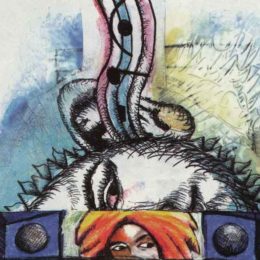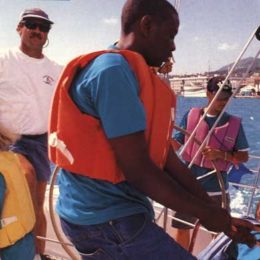When you arrive at the village of Macuro, your hosts bring their wheelbarrows to meet you. There is no other transport. Your bags are trundled off, up the broad half-cobbled main street, to the guesthouse (posada) or to a private house. Macuro, an isolated community in Sucre, Venezuela’s most eastern state, is not a Caribbean “fun in the sun” sort of place; nor, indeed, is anywhere in Sucre, although its beaches can compete with the Caribbean’s finest. Sucre is far more interesting than that.
Macuro is a long way from anywhere. Tucked under the arm of the Paria peninsula that stretches out almost to Trinidad, it can be reached by a two-and-a-half-hour boat ride from Guiria, a hot little port on the Gulf of Paria now beginning to boom from a new oil project. Besides the wheelbarrows, waiting to greet you is a statue of a European gentleman, overdressed for the tropics, in the cloak and hat of long ago, his hand raised. It is, of course, Columbus: Macuro was the only place on the South American mainland where he ever set foot.
The 500th anniversary of that occasion takes place this year. The farmers and fishermen of Macuro hope to commemorate that moment in their own way, independent of the establishment (as they demonstrated not long ago when they declared autonomy from the Caracas government in the face of an electricity power cut that lasted a year. For some time Macuro was its own master).
Macuro is that sort of place: and you can glean more of that story at its museum, the eccentric creation of one of those outsiders who are attracted to out-of-the-ordinary places. Eduardo Rothes was a war correspondent before he arrived in Macuro: an intellectual with radical sympathies, he is as interesting as any of the gothic artifacts that feature in his museum.
It’s difficult — literally — to leave Macuro. You must take the boat back to Guiria, head for the north coast by hiking through the cloud forest of Paria’s national park, or take a boat round the peninsula through the fearsome Boca del Dragon (Dragon’s Mouth) that forms part of the turbulent channel between Sucre and Trinidad, where the Caribbean Sea and the Atlantic Ocean meet.
Of all the states of Venezuela, Sucre, and especially its coastal communities, are closest to the Caribbean both geographically and culturally. The thriving carnivals of, for example, Carupano (on the Caribbean coast) and Guiria are fuelled by a strong African tradition; with steelbands, carnival queens, costume processions and calypso, they have a real similarity to those of the English-speaking Caribbean.
In Guiria, and in the neighbouring (and prettier) town of Irapa, there are other Caribbean influences. The architecture, for example: some houses feature verandahs that overhang the street or show off delicate wooden gingerbread fretwork. It is less Spanish colonial, more Caribbean creole. The people of these towns play a form of cricket called batinball and sing calypso. There have been links with Trinidad for generations.
Eastern Sucre also has a Caribbean flavour. Behind the white-sand-and-coconut bays of the Caribbean coast is the rain forest of the Paria peninsula, where plantations and small holdings of coffee and cacao resemble parts of Trinidad, Jamaica or Dominica. The settlements along the Caribbean coast are only accessible by boat: Uquire, a fishing village backed by great curtains of greenery; the pretty village of Santa Isabel. The great stretch of coastal emptiness comes to an end at San Juan de las Goldonas, which has it own road stretching west to the lovely colonial town of Rio Caribe, with its fine Spanish colonial homes. Once, slaves were brought here from the eastern Caribbean to work for the Spanish and Corsican cacao planters. Rio Caribe is one of Sucre’s tourist centres, and a focus point for its network of posada. These small guesthouses offer simple accommodation (and sometimes food and drink); usually family-owned, they can be urban and rural, by the beach or in the countryside. Some cater mainly for Venezuelans on holiday from the cities; others for the international market, for travellers who want local life and lore.
The posadas are now boosting Sucre’s tourism, which has traditionally been a marginal activity. But the posaderos are now getting stronger local support, and business is growing. There are even plans for a Club Med at Playa Medina, one of Sucre’s most beautiful bays.
Sucre has wetlands (great for bird watchers), the mangroves along the Gulf of Paria and the rain forest of the Paria Peninsula, the fresh “alpine” pastures of Santa Fe de Altos and the semi-desert of Araya. A passenger ferry goes to Araya from the state capital, Cumana, the first site to be settled in Latin America, its colonial architecture decimated by earthquakes. Araya too has built up a small tourist industry based around posadas. Along the coast is the even smaller fishing village of Punta Arenas, with a handful of simple posadas for beach-combers.
All along the Caribbean coast, tourism is stirring. At the fishing village of Santa Fe, for example, there are half a dozen relaxed posadas on the beach where, at some times of year, dolphin watching at breakfast is the attraction. Half an hour away, there is the spick and span village of Mochima, where posadas and private homes allow visitors to explore the private coves of the Mochima national park.
Sucre seems, for the moment, to be developing its tourism from the bottom up, instead of the top-down approach of condominiums, cruise ships and casinos. Don’t expect a luxurious holiday with cable television and room service (although there are certainly some stylish and charming posadas in the making). Here is a culture which still reflects the first impressions of the conquisitadores who, for all their greed, saw Sucre and called it Tierra de Gracia (land of grace).
















